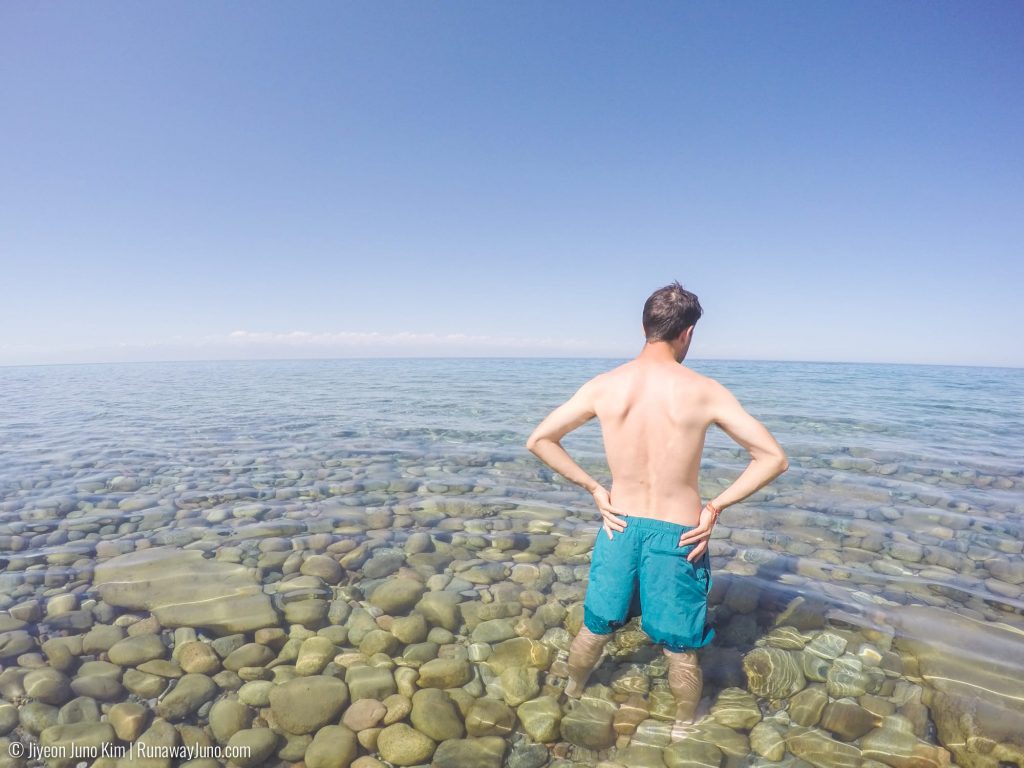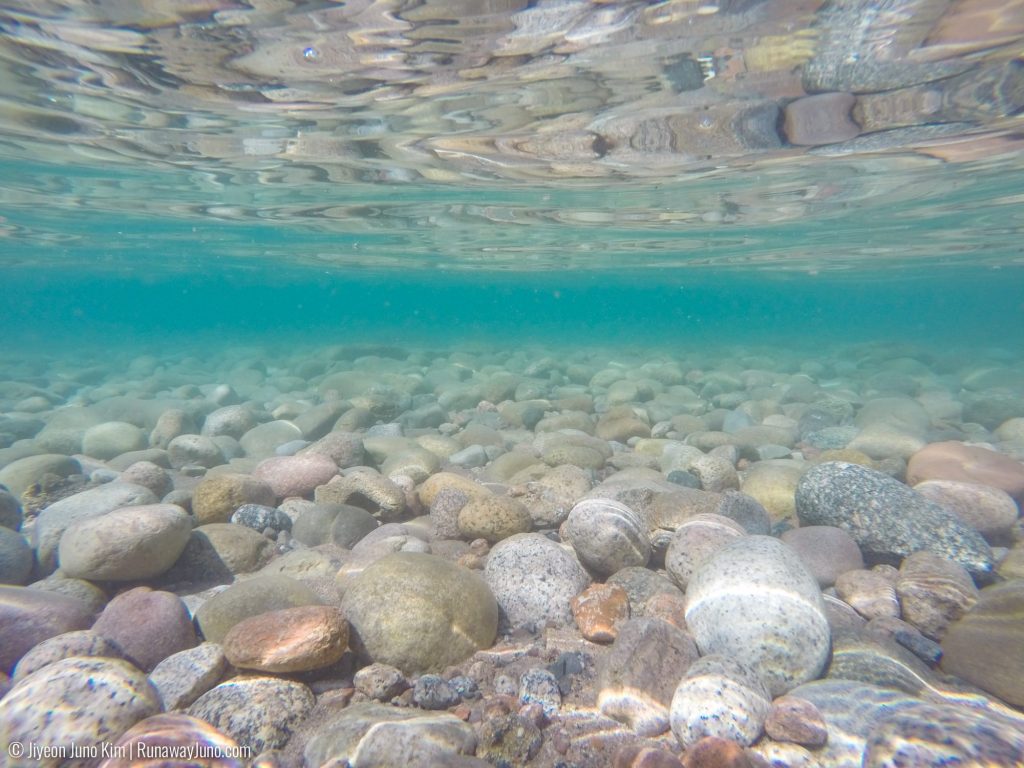Issyk-Kul Lake: Who knew I could go on a beach vacation in Kyrgyzstan?
What do you picture when thinking about Kyrgyzstan? Yurts, horses, mountains, dusty roads, and perhaps remnants of the Soviet Union? Yes, all are typical things you can find in Kyrgyzstan. What surprised me was the fact that Kyrgyzstan is a country of lakes, like Issyk-kul. There are more than 2,000 lakes, although most of them are small. The majority of lakes are located in the mountains, between 2500 – 4000m elevation. It’s one of many reasons that makes hiking in Kyrgyzstan so satisfying.
After visiting a few lakes in the mountains, we finally reached the famous Issyk-Kul, translated as “hot lake”, also known as the pearl of the Tien Shan. Issyk-Kul has a lot of titles; it’s the biggest lake in Kyrgyzstan, the tenth-largest lake in the world by volume, the second-largest saline lake after the Caspian Sea, and the second-highest mountain lake in the world (elevation) after Lake Titicaca in Peru/ Bolivia (elevation).

Issyk-Kul was the last destination of our trip, coming down from a three-day, two-night hike in Kol-Ukok. Sleeping in a yurt for two nights, we were ready to take a jump into any body of water. It was a relatively short drive from Kochkor to Issyk-Kul, taking about two hours on a dirt road.
We had seen the second biggest lake in Kyrgyzstan, Song-Kul, but Issyk-Kul appeared to have a very different atmosphere. Driving along the lake reminded me of a beach vacation. In fact, as a landlocked country, the Kyrgyz consider coming to Issyk-Kul as their beach vacation, because, well, this is the closest thing to a beach they have. The climate here is also quite pleasant. Located in between mountain ranges, the temperature here is always around 25 degrees Celsius, which is the definition of a pleasant temperature for me.

Dipping into this crystal clear water after long days of hiking felt like I had everything I needed right here. The water was unbelievably clear, I could see the bottom far away, which was covered with big pebbles. With the shining sun, a bit of breeze, and clear and cold water, I couldn’t believe a place like this existed in the mountains. I’ve known about this place before I came but certainly, I didn’t expect it to be this pleasant and wonderful. Who knew I could go on a beach vacation in Kyrgyzstan?
The name: Issyk-Kul
Issyk-Kul, meaning warm lake in the local language, was given such a name because it never freezes over during the winter. It is certainly warm enough to swim in summer but it’s not warm by temperature.
The geography of Issyk-Kul
- The second-highest lake in the world after Lake Titicaca, Issyk-Kul sits at an altitude of 1,607 meters (5,272 ft) and reaches 668 meters (2,192 ft) in depth.
- The lake’s southern shore is dominated by the Teskey Ala-Too Range of the Tian Shan mountains. The Kungey Alatau of the Tian Shan runs parallel to the north shore.
- About 118 rivers and streams flow into the lake but there’s no outlet.
What to do in Issyk-Kul
Swim, swim, and swim

The water is as clean as can be. It’s truly amazing to float on water like this. When planning to visit Issyk-Kul, make sure to plan enough time to just hang out by the water. That’s the best thing you can do here. The lake looks completely different during sunrise, midday, and sunset.
Skazka Canyon (Fairy Tale Canyon)

The famous Skazka (fairy tale) Canyon is located on the southern shore of Issyk-Kul Lake. Driving along the shore, we passed Arizona or Utah-like landscapes for miles, then entered the fairytale land. This ever-changing landscape has been telling stories for centuries. The colors, yellow to red and orange, were created because of the different chemical composition of the rocks. You can climb any hills you see here to explore the different vistas that these colors make.
Tamga-Tash

Tamga Gorge is located along the southern shore of the lake, near the village of the same name, and means “letter” or “print” in the local language. Tamga-Tash is a bas-relief stone with Tibetan inscriptions dating back to 8-9th centuries. It’s known to be a common Buddhist prayer “Om Mani Padme Hum”. There is a legend that the famous folklore hero Batyr split the sword through Tamga-Tash, and inscribed on it the number of trophies. The stones are revered by Buddhists all over the world as sacred.
Yurt making workshop

Did you know there are 102 yurt-making masters living in Kyzyl-Tuu village, which has a population of 1400? It’s 30km away from Bokonbaevo. About 80% of the villagers work as yurt makers. Have you wondered how in the world they travel with the yurt and set it up each time? Finally, I got the answer from this 20-minute yurt-making workshop. I was stunned to see how genius the structure is and easy to set up if you know what you are doing. Visitors are welcome to tour the village and participate in the workshop. We visited a master yurk maker’s shop, who made the biggest yurt I’ve ever seen in Bel Tam Yurt Camp. His team of 6 men can set up the yurt in 10 minutes. Even by an expert’s standard, that’s fast. The tour can be arranged through the CTB Bokonbaevo office in town.
Where to stay
There are many places to stay all around Issyk-Kul on both the northern and southern shore. Both sides have a very different atmosphere, the south side is less populated than the north. There are yurt camps, hotels, campgrounds, and many other different places to stay. We stayed at Bel Tam Yurt Camp. I consider this a four-star yurt camp, after traveling Kyrgyzstan for 8 days and sleeping in yurts with nomad families. There’s a hot shower, flush toilet (which is very rare in Kyrgyzstan countryside), electricity, and a nice common yurt and bar to hang out in.
Now there are more options. Check out our friends at Feel Nomad Yurt Camp. The camp is located on the southern shore of Issyk Kul. They built the biggest yurt made of wood and they are eco-friendly. They serve traditional Kyrgyz food and plenty of activities you can do from there, including trekking, bike tours, kayaking, and so on.
#Disclaimer: This trip was made possible by the support of the American people through the United States Agency for International Development (USAID). The contents are the sole responsibility of the author and do not necessarily reflect the views of USAID or the United States Government.